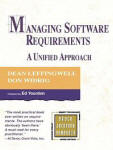






Bill Wiley
iUniverse, 2014
ISBN: 1491747269 (paper)
Buy it from Amazon.com (commission paid)
Buy it from Amazon.co.uk (commission paid)
Bill Wiley will be known to some readers as the author of the well-respected Essential System Requirements. That book made extensive use of (business) events to organise requirements into time-sequences, scenarios (or parts of them), but without saying much about scenarios or use cases.
This little book focuses more particularly on threading events together, and is unambiguously organised around use cases. What is more, it is still clearly focussed on the systems development process, which itself is very straightforwardly treated as a use case.
The book thus makes use of some UML concepts. Wiley combines these with some more traditional software engineering approaches, using domain models (effectively, context diagrams) with data flows. The arrival of a business event is of course a key element in such a model.
The Event Thread for Requirements is organised into three "books".
Book 1, The Event Thread, describes the basic concepts, and shows how a business event is a natural representation of things that happen in a typical system, and how those events can be handled with use cases. Each way of traversing such a use case is an event thread (I'd call that a scenario), and it corresponds to a test case: hence, each thread is a separate piece of work (shades of agile development), and in Wiley's system engineering perspective has its own development lifecycle - from specification to development to testing to release.
Book 2, The Event Thread and Methodology, steps through the event-based method and shows the advantages of specifying and partitioning systems in this way.
Book 3, Case Study, provides a set of artifacts for a simple model - if I tell you that the use cases are called Fill Customer Order, Return Item Availability, Return Order Status, Generate Weekly Sales Report, Apply Item Discount, and Return item, you will quickly appreciate that Wiley illustrates the book with a business-oriented case study. He ends with a list of the test cases required.
This is a clear, well-organised requirements book that blends the old with the new into a simple, powerful method suitable for a wide range of business applications. I have no doubt that a project that quietly follows its instructions will have a greatly improved chance of completing on time, to budget, to the specified quality. Who could ask more than that?
© Ian Alexander 2015
You may also like: